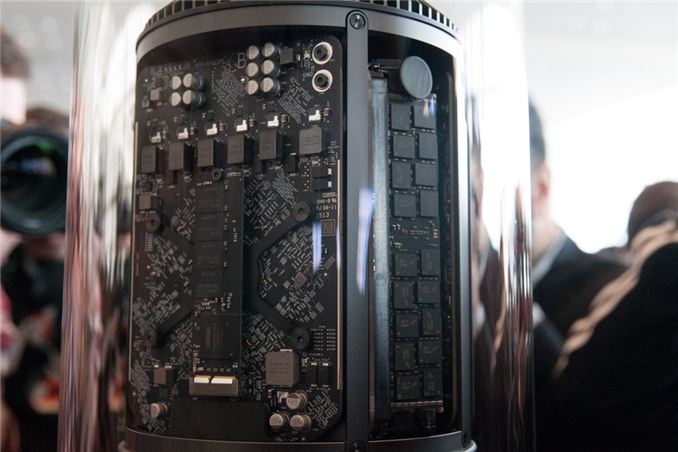Up Close with the New Mac Pro
by Anand Lal Shimpi on June 10, 2013 3:15 PM EST
In its keynote this morning, Apple teased its next-generation Mac Pro, due out later this year. Based on Ivy Bridge E, the new system will ship with two AMD FirePro GPUs with up to 4096 SPs and capable of delivering 7 TFLOPS of peak FP performance.
We got a close look at the chassis, which is 1/8 the size of the current Mac Pro. You lose any hope for internal expansion, but Apple outfitted the machine with three Falcon Ridge Thunderbolt 2 controllers to enable expansion via external storage and external Thunderbolt 2 expansion chassis options. Apple won't make any of its own Thunderbolt 2 expansion chassis, but you can expect that others will fill that void. With 20Gbps up/down on Thunderbolt 2, you should have enough bandwidth for any PCIe expansion.
Internally there are four DDR3 memory slots, as well as what looks like a proprietary PCIe SSD connector (I don't think it's M.2 unfortunately). Both GPUs are technically removable, but at least one is mounted as the same card as the PCIe SSD. Apple is putting every single PCIe lane available to use on the new Mac Pro.
















137 Comments
View All Comments
vFunct - Tuesday, June 11, 2013 - link
dual-workstation GPUs in a system with a single fan?? WTF?This system probably has the highest compute density of any system on the planet.
The PS4/Xbox One probably doesn't have the same level of compute per volume.
lukarak - Tuesday, June 11, 2013 - link
This has less volume than Xbox One i think. And a few times more compute performance.tipoo - Monday, June 10, 2013 - link
"Besides, you're supposed to upgrade both the GPU and CPU together. Pros upgrade their machines every 5 years anyways. They never upgrade the GPU separately."...What? Some pros never upgrade the internals, some do. Say one needs to do lots of GPGPU work and two years down the line cards are so much more powerful for him it would be worth upgrading the video card, but not throwing out the whole computer.
steven75 - Monday, June 10, 2013 - link
What's this talk about "throwing out the whole computer" about? Unlike PCs, Mac Pros hold their value extremely well. Trade up if 2 year-old GPUs are that huge of a deal.vFunct - Tuesday, June 11, 2013 - link
The only pros that ever upgrade are the ones that didn't bother to get the top-end graphics card in their system in the first place.The current Mac Pro pretty much has the same graphics card lineup for the last 3 years. Anyone that upgrades would have upgrade to something that was available 3 years ago.
Apple went ahead and made sure the default GPU was high-end enough so that you would never even THINK about upgrading, because you weren't given the option of buying the low-end card in the first place.
Freakie - Tuesday, June 11, 2013 - link
Did you miss the part about "Up to" in the graphics options? Apple always offers low end GPU's so your assessment of the GPU being "high-end" is false right off the start.And to even say that the highest GPU they offer is "high-end enough" after saying that those who upgrade later never bothered to get the best to begin with is rather silly, because you're saying that what they offer is "enough" not that it's the best. They will not offer the best, and that's a fact. Especially seeing as, in the compute world, applications are so sensitive to what hardware they are running on that there is no "best".
And of course, the idea that a GPU that is 3 years old is some how not worth upgrading is also quite laughable. GPU's can change a lot in the time frame, and many people find that the massive gains they would get from the latest generation are well worth the investment.
Freakie - Tuesday, June 11, 2013 - link
4 GPU's anyone? Pretty sure that's a better upgrade. Put it on a rackmount server and you have REAL compute density.And no, you don't upgrade the CPU's and GPU's at the same time. There are MANY compute heavy tasks that are reliant on GPU's way more than CPU's. It's usually very cost ineffecient to upgrade CPU's on a GPU bound task, and therefor many people just upgrade GPU's (this is true for both professional compute and gaming). As for upgrade frequency, 5 years is really the max, most upgrade way more frequently than that.
jeffkibuule - Monday, June 10, 2013 - link
While GPUs have always taken the x16 slot, I don't think they really need it: http://www.anandtech.com/show/5458/the-radeon-hd-7...tipoo - Tuesday, June 11, 2013 - link
This is still internal PCI-E. Tomshardware found Thunderbolt had much bigger losses despite the speed. There's latency and other things involved.DanNeely - Monday, June 10, 2013 - link
The bandwidth constraint is less of an issue for GPU use. PCIe3.0 x2 isn't a problem for most games; only 2/8 games AT tested showed significant penalties at x2, and only one was hurt badly enough I'd consider it a showstopper. Where it's a potential killer is GpGpu workloads that need significant levels of back and forth communication with the CPU. Some (ex Einstein@Home) will take a significant slowdown even from only having an x8 slot on higher end GPUs.I'm wondering though if multiple TB ports can be aggregated so that an enclosure with 2 TB connections could offer an effective x4 link.
http://www.anandtech.com/show/5458/the-radeon-hd-7...